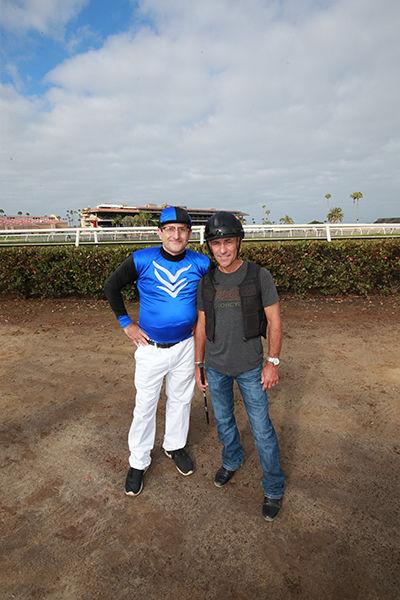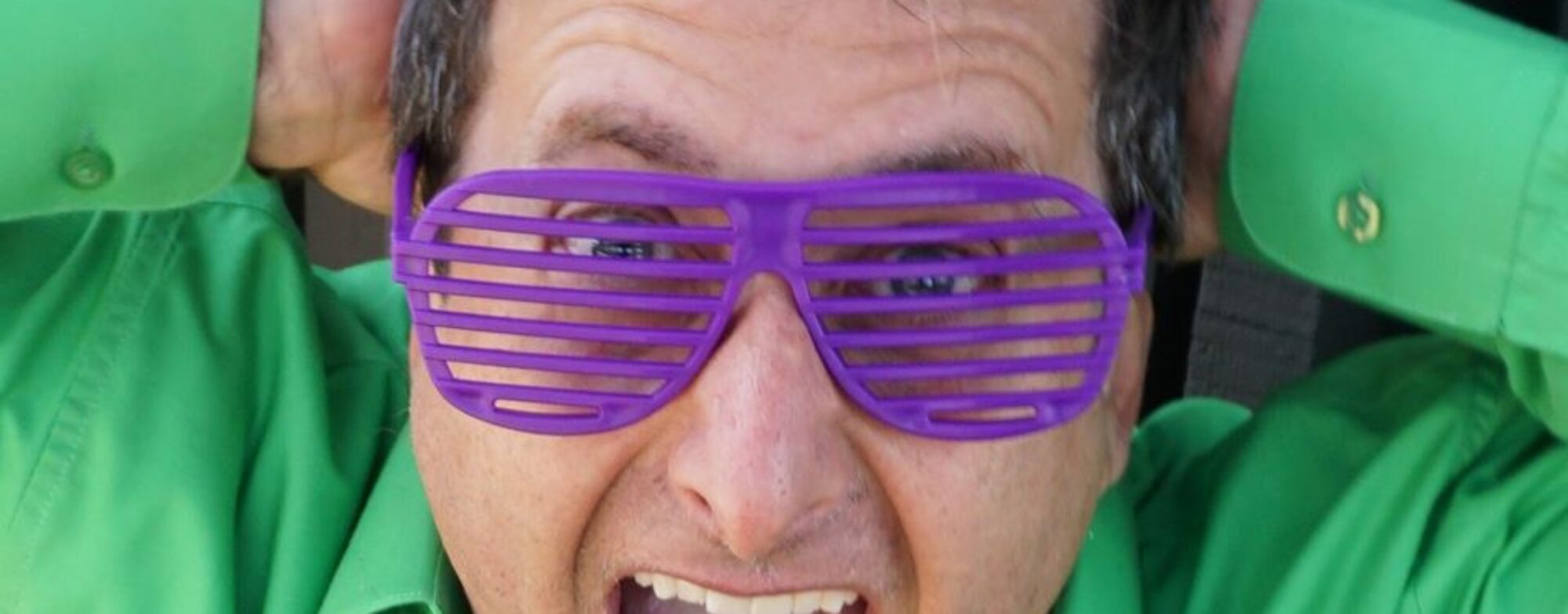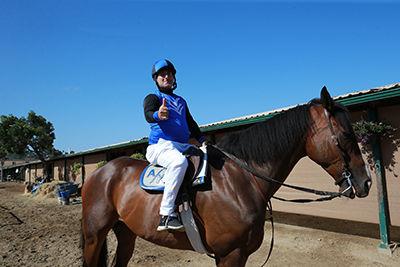By COREY LEVITAN
Standing 5-foot-6 with a voice that sounds like I inhaled helium, I always felt a pull toward horse racing. It’s the world’s only sport I may actually be too tall to qualify for.
“Your belly’s in the way!” Gary Stevens screams in the jockey exercise room at Del Mar Racetrack, where my training begins at 6:30 a.m. on the Equicizer, the mechanical horse on which Tobey Maguire trained to be a pretend jockey for the 2003 movie Seabiscuit.
To celebrate San Diego’s first turn hosting the Breeders’ Cup on November 3rd and 4th, I decided to find out what makes jockeys tick as one of them for a day. And I have none other than legendary Hall of Fame jockey Gary Stevens, who won 11 Breeders’ Cups, train me.
“You’re supposed to lean forward toward the neck with your ass off the saddle,” Stevens continues, laughing as he gives up before even turning the machine on, “but your belly’s in the way!
“Are you kidding me?”
Stevens retired in 2005, after reaching 5,000 race victories. Then he spent several years in Hollywood, where his credits included parts in Seabiscuit and the 2011 HBO miniseries Luck.
Seven years later, he slipped back into the irons. “I was bored,” he says. “I liked acting, but it was getting a little bit monotonous. I had the itch to come back, and my body felt good.” At age 50, Stevens became the oldest jockey to win a Breeders’ Cup on a horse called Mucho Macho Man at Santa Anita. It’s a record he hopes to break again next month in Del Mar at age 54.
By the way, I’m wrong about height qualifying someone to be a jockey. It’s pure weight. Yes, Stevens is 5-foot-4. But most jockeys are short only because more height tends to confer more weight. Eating is more of a preoccupation to jockeys than it is to supermodels. Stevens weighed in at 120 lbs. this morning but is listed in the program as 116 lbs. “I thought I was lighter than that,” he says. “My whole day just changed in three seconds.”
Because horse racing is a game of inches, 2-3 lbs. can often distinguish winning from losing. So Stevens must now try to lose as much weight as possible before his two races this afternoon. (Between the Equicizer, galloping his horses and the steam room, that’ll be an amazing 2 lbs. He’ll ride both Little Bit Lovely and Dynamic Mizzes K to fourth place—but not before being fat-shamed. An announcement will state that the horses are carrying two more pounds than listed.)
“Weight is a constant awareness,” Stevens says. “When I’m on vacation, I won’t even step on a scale because it makes me anxious.”
Horse racing is a family business to Stevens, who entered when he was 14 years old in Idaho. His dad, Ron, was a horse trainer and his mom, Barbara, a rodeo queen. His older brother Scott, 57, still races.
“What motivates me now is the same thing that motivated me then—winning,” Stevens says. “I’m not thinking about anything else. And that’s the kind of person you need to be to make it in this business.”
According to Stevens, only 5 percent of licensed U.S. jockeys earn more than $50,000 a year. Even those lucky enough to have won multiple multi-million-dollar purses, like Stevens, have costs that most fans don’t think about.
“Depending on what state you’re in, 60 percent goes to the owner, and you get 10 percent of that,” Stevens says. “Out of your 10 percent, you pay your agent 25 percent and your valet 2.5 percent and stake the workers in the barn, the exercise rider, and the assistant trainer. So you’ve got to be in it for more than money.”
It’s not possible to overstate the danger of riding horses for a living, either. Between 1940 and 2012, 152 jockeys died on the job. Stevens, nicknamed “Bionic Man” because of all his replacement body parts, was nearly one of them. Several times.

When asked to describe his worst injury, Stevens instead shows me on his smartphone – someone uploaded it to YouTube. Titled “2003 Arlington Million (fall),” the clip shows Stevens
tumbling off a spooked stallion named Storming Home and getting kicked in the head and back numerous gruesome times.
“That’s from the nerves from my broken neck,” he says, explaining why his fingers wiggle randomly as he lay motionless on the track.
Stevens then turns to me with a stare that burns into the back of my eyeballs and asks: “So, you think you’ve got what it takes?”
Stevens walks me to the stable where the horse I will learn to ride, named Tiger, awaits my freshly acquired jockeying skills. Many of Stevens’ jockey friends try hiding their laughter as they spot me waddling by in my Abbondanza Racing silks, before realizing I’m in on the joke.
“He’s looking for an agent if anyone’s interested!” Stevens announces.
“Hey, it’s the next Chuck Lopez!” someone yells back.
Tiger’s trainer, Manny, waves us over to the stable. It’s time for my moment in the saddle.
I’d like to say I thundered Tiger down the dirt before the track opened to the public. I’d like to say it felt like fate to fit my feet in the stirrups, grasp the coarse reins in my hands and assume the jockey stance in a moment that forever changed my life.
But I can’t say any of that. Tiger is a 10-year old lead pony who no longer races. (Lead ponies walk the procession of racehorses to the starting gate for each race.) The only dirt we ride on is beside his stables on the track’s backside. And Tiger is being walked around by a very nervous Manny, not thundering in my hands. That’s all the jockeying Tiger’s owner would allow me to experience, citing such trivialities as “liability,” “regulations” and “sanity.”
“Have you even ridden a horse before?” Stevens asks.
Actually, back at Camp Merrick Woods in Long Island, they had a stallion that walked in circles around a corral and let you feed him carrots. I’m pretty sure his name was Mr. Ted. And, let me tell you, I handled Mr. Ted better than any other camper could.
“My apologies,” Stevens says sarcastically. “You totally got this.”
Eventually, my whining breaks Manny down. Against his better judgment, he relinquishes control and Tiger is all mine. He’s only walking, but I drop into jockey stance anyway—at least until Manny asks me to please sit up straight. Then I give Tiger the gentlest of kicks and he lurches forward. For three seconds until he slows back down, I see my dead grandmother at the end of a long tunnel of light.
And that three seconds, Stevens tells me, is precisely what being a jockey feels like.
What’s the difference between Gary Stevens’ jockey career and mine? I’m retired for good. Watch Stevens ride in the very first Del Mar Breeders’ Cup on November 3rd and 4th.

